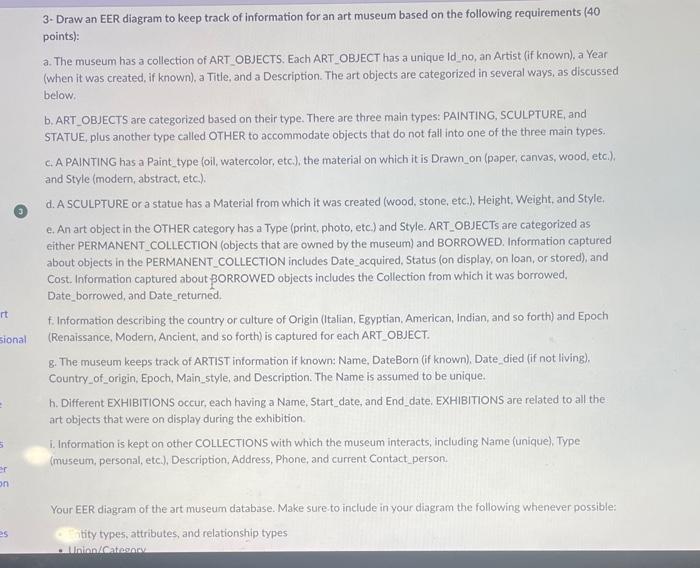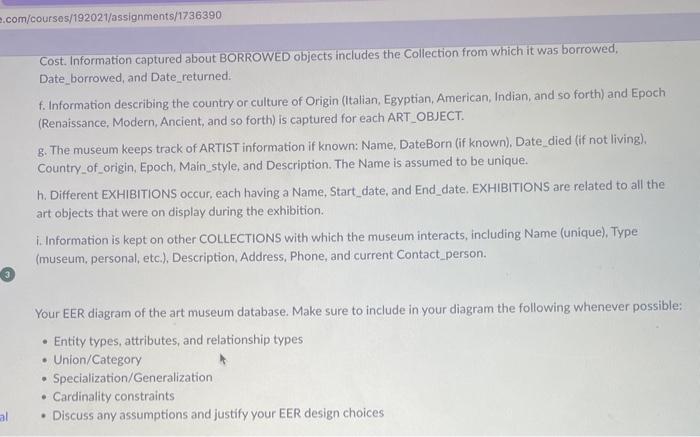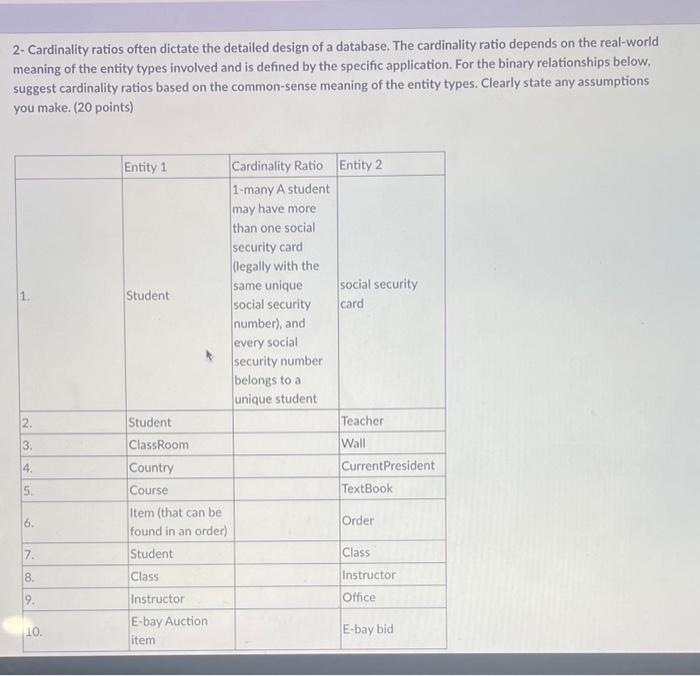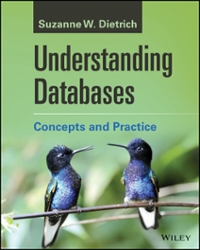Answered step by step
Verified Expert Solution
Question
1 Approved Answer
please answer all parts 3. Draw an EER diagram to keep track of information for an art museum based on the following requirements (40 points):
please answer all parts 


3. Draw an EER diagram to keep track of information for an art museum based on the following requirements (40 points): a. The museum has a collection of ART_OBJECTS. Each ART OBJECT has a unique Id no, an Artist (if known), a Year (when it was created, if known), a Title, and a Description. The art objects are categorized in several ways, as discussed below. b. ART_OBJECTS are categorized based on their type. There are three main types: PAINTING, SCULPTURE, and STATUE, plus another type called OTHER to accommodate objects that do not fall into one of the three main types. c. A PAINTING has a Paint_type (oil, watercolor, etc.), the material on which it is Drawn_on (paper, canvas, wood, etc.), and Style (modern, abstract, etc.). d. A SCULPTURE or a statue has a Material from which it was created (wood, stone, etc.), Height, Weight, and Style, e. An art object in the OTHER category has a Type (print, photo, etc) and Style. ART_OBJECTs are categorized as either PERMANENT_COLLECTION (objects that are owned by the museum) and BORROWED. Information captured about objects in the PERMANENT_COLLECTION includes Date_acquired, Status (on display, on loan, or stored), and Cost. Information captured about BORROWED objects includes the Collection from which it was borrowed. Date_borrowed, and Date_returned. f. Information describing the country or culture of Origin (Italian, Egyptian. American, Indian, and so forth) and Epoch (Renaissance, Modem, Ancient, and so forth) is captured for each ART_OBJECT. 8. The museum keeps track of ARTIST information if known: Name, DateBorn (if known), Date_died (if not living). Country_of_origin, Epoch, Main_style, and Description. The Name is assumed to be unique. h. Different EXHIBITIONS occur, each having a Name, Start_date, and End_date, EXHIBITIONS are related to all the: art objects that were on display during the exhibition. i. Information is kept on other COLLECTIONS with which the museum interacts, including Name funique), Type (museum, personal, etc.), Description, Address, Phone, and current Contact.person. Your EER diagram of the art museum database. Make sure-to include in your diagram the following whenever possible: Cost. Information captured about BORROWED objects includes the Collection from which it was borrowed, Date_borrowed, and Date_returned. f. Information describing the country or culture of Origin (Italian, Egyptian, American, Indian, and so forth) and Epoch (Renaissance, Modern, Ancient, and so forth) is captured for each ART_OBJECT. g. The museum keeps track of ARTIST information if known: Name, DateBorn (if known), Date,died (if not living). Country_of_origin, Epoch. Main_style, and Description. The Name is assumed to be unique. h. Different EXHIBITIONS occur, each having a Name, Start_date, and End_date. EXHIBITIONS are related to all the art objects that were on display during the exhibition. i. Information is kept on other COLLECTIONS with which the museum interacts, including Name (unique), Type (museum, personal, etc.), Description, Address, Phone, and current Contact_person. Your EER diagram of the art museum database. Make sure to include in your diagram the following whenever possible: - Entity types, attributes, and relationship types - Union/Category - Specialization/Generalization - Cardinality constraints - Discuss any assumptions and justify your EER design choices 2- Cardinality ratios often dictate the detailed design of a database. The cardinality ratio depends on the real-world meaning of the entity types involved and is defined by the specific application. For the binary relationships below, suggest cardinality ratios based on the common-sense meaning of the entity types. Clearly state any assumptions you make. ( 20 points) 


Step by Step Solution
There are 3 Steps involved in it
Step: 1

Get Instant Access to Expert-Tailored Solutions
See step-by-step solutions with expert insights and AI powered tools for academic success
Step: 2

Step: 3

Ace Your Homework with AI
Get the answers you need in no time with our AI-driven, step-by-step assistance
Get Started


